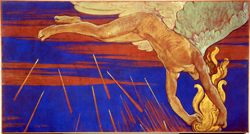The Wolfson Collection


italiano | english

Works from the Historical Archives of the Venice Biennial January 17 - May 1 2007
The exhibition documents the important
relationship between Galileo Chini, one of the principal protagonists of
Italian and international art during the first half of the twentieth
century, and the Venice Biennial. The pavilions he designed remain among the
most celebrated decorative series in the exhibition’s remarkable history.
The exhibit gives particular attention to two of the most important examples
of this diligent and fruitful collaboration: the first for the Sala L’Arte
del Sogno, prepared in 1907 with Plinio Nomellini, Gaetano Previati and
Edoardo De Albertis, and the second for the Mestrović Salon, characterized
by a series of allegoric panels depicting the militaristic strength and
heroism of the Italian army.
In 1907, in the frieze for the Sala L’Arte del Sogno, Chini created a series
with dancing putti, a theme he first explored for the 1906 Milan
International Exposition.
In 1920 he created a cycle of fourteen panels to express the glories of war
and victory with a late symbolistic allegorical emphasis.
This show is made possible by the gracious loan from the Fondazione La
Biennale di Venezia. Archivo Storico delle Arti Contemporanee of twelve
works recently restored with financial support from the Venetian Heritage
Fund. Together with documents from the Wolfsoniana, the Chini Archive of
Lido di Camaiore and the Ares Multimedia Archive of Genova, these works
represent a series of important examples related to Chini’s work as a
decorator and his special relationship with the Venice Biennial.
Galileo Chini (Florence 1873 - 1956) was painter, ceramist, illustrator, set
and costume designer. His earliest Art Nouveau ceramics led to great success
at the international exhibitions in London (1898), Paris (1900), Brussels,
Gand and Petersburg (1901), Turin (1902), and St. Louis (1904).
In 1896 he founded L’Arte della Ceramica (The Arts of Ceramics)
manufacturing in Florence that moved to Fontebuoni in 1901. His experience
there influenced the painting La fabbrica (The Factory), which can be seen
on the first floor of the museum. Over the next decade, Chini was strongly
influenced by the works of Gustav Klimt and his naturalistic style evolved
to take on more geometric and highly stylized forms. He was a regular
participant in the Venice Biennial shows from 1901 to 1936. He was a
prolific artist, creating the temporary spaces for some of the most
important shows of the period as well as designing interiors for buildings,
homes, churches, and chapels most notably in the major centers of Tuscany:
Florence, Pistoia, Arezzo, Montecatini, Lucca and Prato.
Perhaps his most famous commission came in 1911 from the king of the Siam
who had been introduced to Chini’s work at Venice. The king brought Chini to
the Orient to create frescoes for his throne room in Bangkok. The experience
had a profound effect on the artist’s style, and when he returned to Italy,
Chini evolved toward the new Deco language, as it can be seen in the two
large planters he designed for the Berzieri Thermal Spa in Salsomaggiore and
which are now a part of the permanent collection of the Wolfsoniana.
This was also the beginning of Chini’s most active creative period, during
which he created his designs for the Gran Caffè Margherita and the Grand
Hotel Excelsior in Viareggio (1922), the Grand Hotel des Thèrmes in
Salsomaggiore (1925), as well as set designs for Giacomo Puccini’s Turandot,
which were first seen on stage after the composer’s death.
Contemporaneously, Chini also worked on large interior spaces for the
oceanliners Roma, Augustus and Ausonia, and for two hydroelectric power
stations in Alto Adige and for the headquarters of the Montecatini
Corporation in Milan. In the 1930s he demonstrated a new preference for
easel painting, showing his work in a number of both public and private
spaces. Chini developed health problems at the end of the decade which
eventually led to blindness in the 1940s.